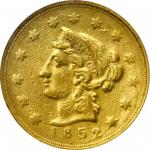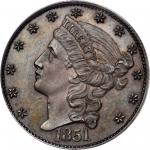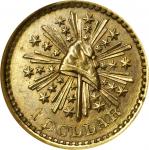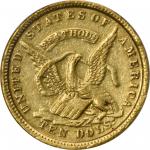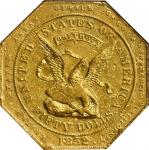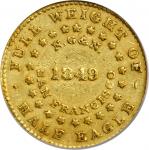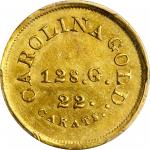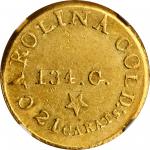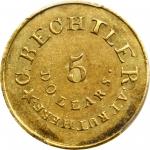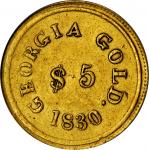1852 Wass, Molitor & Co. $10. K-3. Rarity-7. Small Head. AU-50 (NGC).Bathed in a rich olive-gold patination with just the faintest of traces of crimson highlights around the truncation of Libertys neck and within the letters on the reverse. The soft strike is typical for the type, possibly from reworking the earlier Dubosq dies. The surfaces bear only light to moderate abrasions typical of pioneer gold coins with none of the serious detractions that would take away from the overall pleasing eye appeal. An outstanding example of an all-around challenging issue. The firm of Wass, Molitor & Company was founded by Count Samuel C. Wass and Agoston P. Molitor, both expatriates in the aftermath of the 1848 Hungarian independence movement. Trained in metallurgy and seeing opportunity in the gold fields of California, the pair announced the formation of Wass, Molitor & Co. as an assay office on October 14, 1851. Initially the firm did not intend to strike their own coins but not long after opening their doors, they announced in January 1852 to begin producing what they referred to as small coin in $5 and $10 denominations. The purity levels of the new coins fell below federal standard, so in order to compensate for this, the coins were intentionally made slightly heavier, which helped encourage their acceptance in commerce. For the $10 coins, Wass, Molitor & Co. used dies were originally prepared for and used by Dubosq & Co. for their $10 gold pieces dated 1850. In 1851 when that firm shuttered its doors, the dies were sold to Wass & Molitor, who then made some modifications for their own use. Recent research has shown that both the obverse and reverse dies were used to produce the K-3 Small Head $10. The reverse die was put into use little or no change, but the obverse die was carefully reworked to remove traces of the DUBOSQ & Co. on the headband and replace it with W. M. & Co.; on high grade examples hints of the U and S in DUBOSQ are visible under the first and second periods. In addition, there is a circular raised area under the 2 in the date where what is now thought the original 0 in the date was drilled out and replaced with the 2. With die steel at a premium in the West, this technique was later employed on the 1855 $10 which also exhibits a similar raised platform. Of the two varieties of 1852 $10 gold piece, the Small Head is quite a bit rarer and challenging to acquire in any degree of preservation. Best estimates place about 15 to 20 known specimens, none of which are Mint State. In fact, neither of the principal certification services has confirmed an example better than AU-55. The addition of an AU Small Head $10 is a notable achievement worthy of celebration.From the Samuel J. Berngard Collection.

